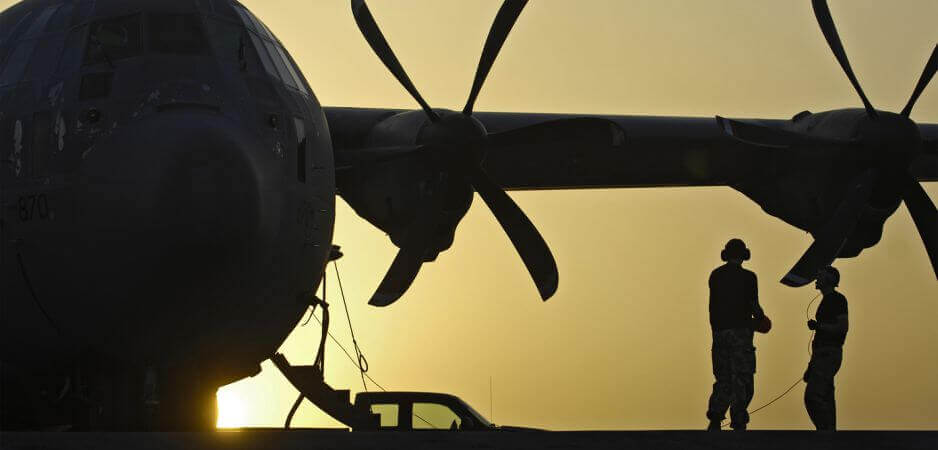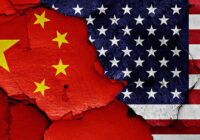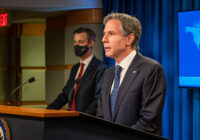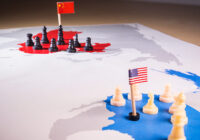Amid US airstrikes on Syria, the future of Eurasia is up for grabs.
One thing this week’s US airstrikes in Syria highlight is the fact that the sands are continuously shifting as regional and world powers jockey for position in a future Eurasian world order. The strikes raise questions that go far beyond potential greater US involvement in the Syrian conflict. The answer to those questions will likely impact the role America may play in Eurasia and the Asia Pacific.
What is surprising is not the fact that US President Donald Trump ordered the launching of missiles. He has signaled with his appointment of generals in key national security positions as well as his budget proposals a more muscular, military-oriented approach to foreign policy. What that meant has been evident since he came to office in January in greater US military engagement in Yemen.
What is surprising is that days after Trump declared that he was president of the United States, not president of the world, he, clearly taken aback by the horror of the Syrian chemical weapons attack, acted to uphold international law and packaged it in terms of compassion. The US airstrikes obviously countered allegations that he may be beholden to Russia, as well as not unfounded perceptions of Islamophobia or an anti-Muslim bias.
Trump may not have a clearly formulated policy framework. Or maybe he does but wants to keep everybody guessing. He has repeatedly stated that he would not broadcast his intentions to the world. Whichever it is, he is keeping China on its toes with regard to North Korea. He is also keeping Iran on it toes, particularly given the chances that President Hassan Rouhani could lose the forthcoming May election to a hard-liner.
On the notion of the king is dead, long live the king, predictions of a US withdrawal from its role as the guarantor of a world order and US isolationism are premature, even if one is seeing a rollback on liberal US values such as human rights. For Eurasia, this alongside numerous other factors means that the often unspoken notion that China may emerge as an unchallenged power in Eurasia and beyond is equally premature.
No doubt China will be a dominant player, but it will be one of two and more probably three players—the United States and India being the others. No doubt, China has advantages: it has a first starter advantage with the scale and breadth of its One Belt, One Road initiative; its willingness to take short-term losses for long-term gain; and its economic, financial and growing military strength.
Yet all of that is insufficient to guarantee that it will ultimately operate in a unipolar world. More likely it will have to maneuver in a multi-polar world. And that may well be one of the takeaways from this week’s missile strikes in Syria.
NEW WORLD ORDER
Several factors are likely to play key roles in the shaping of a future Eurasian world order.
First, states across Eurasia may be pivoting toward China, but many are hedging their bets. As Saudi Arabia’s King Salman toured Asia in March, his son and powerful deputy crown prince, Mohammed bin Salman, traveled to Washington. Middle Eastern autocrats have embraced Trump lock, stock and barrel, including his controversial travel ban. If anything, the missiles strikes in Syria cemented that. The same hedging strategy is true for democracies like Sri Lanka or Myanmar.
And that is the Achilles’ heel of the approach of whichever power—China, the United States or Russia—jockeying for position in Eurasia. The 2011 Arab popular revolts are perceived to have failed, a discussion that goes too far to embark on here, but the lesson of those uprisings stands. Autocracies that fail to deliver are inherently unstable and history teaches that most autocracies fail to deliver.
The United States, China and Russia are placing their bets to a large extent on autocracies. In recent years, China has experienced the extent of the risk involved in that approach—witness Libya, Sri Lanka and Myanmar. No bet is shakier than the one Russia and Iran have placed on Syrian President Bashar al-Assad. Assad is damaged goods, a pariah, no matter what happens in Syria. Russia and China, as does the United States to a lesser extent, run a similar risk in Central Asia.
Second, China’s riskiest bet may well be in Pakistan, the country where it is investing perhaps the most. The risks are multi-fold. They include unease about the terms of Chinese investment involving massive returns on investment expected by Beijing that sink countries into debt traps and raise questions about the impact on local economies and the lack of a trickledown effect. Energy is the one aspect of Chinese investment, in what supporters describe as the China-Pakistan Economic Corridor (CPEC) and critics have dubbed “Colonizing Pakistan to Enrich China” where the positive impact on an energy-starved country is likely to be most immediate.
In anticipation of the construction boom, the Mian family in Lahore invested $30 million to build a second plant of Fast Cables, one of Pakistan’s largest cable producers. Instead of benefiting from Chinese investment, the family fears bankruptcy. Cables for Chinese-built energy projects are not procured in Pakistan. They are imported tax free from China.
For much the same reasons, protests have disrupted China’s plans for a port and special economic zone in Sri Lanka’s Hambantota. The city’s gleaming, Chinese-built airport operates all of four flights a day.
The story repeats itself elsewhere in Eurasia. The Federation of Pakistani Chambers of Commerce and Industry has raised grave doubts about the impact of CPEC, noting that the demography of Baluchistan, a thinly populated area of 70,000 inhabitants, would dramatically change with the influx of up 2 million Chinese and Pakistanis from other parts of the country.
 The cost of the debt trap in terms of land concessions that change demography is already evident in countries like Tajikistan and has sparked protests in Myanmar. A Pakistani financial brokerage calculates that the Chinese rate of return on investment is a whopping 40%.
The cost of the debt trap in terms of land concessions that change demography is already evident in countries like Tajikistan and has sparked protests in Myanmar. A Pakistani financial brokerage calculates that the Chinese rate of return on investment is a whopping 40%.
What makes Pakistan China’s riskiest investment goes beyond the pattern of commercial terms that are perceived as not being equitable. The port of Gwadar, a key node in China’s string of pearls—a network of ports across Eurasia—was first inaugurated some nine years ago. It’s not much more active than the airport in Hambantota.
Baluchistan is engulfed in an insurgency whose connotations go far beyond ethnic and nationalist aspirations. Political violence in Baluchistan is as much an expression of long-standing local grievances as it is linked to a Pakistani state that sees militant proxies as part of its security, defense and foreign policies. Pakistan has been able to do so with US support in the 1980s during the anti-Soviet jihad in Afghanistan, and since then with the backing of Saudi Arabia and China.
The result is a state in which Sunni Muslim ultra-conservatism has been embedded in significant segments of society as well as key branches of the state, creating an environment in which the potential of violence is significantly enhanced. While Gwadar idles, Chabahar, an Indian-built port in Iran some 60 kilometers further west, is likely to push ahead.
Third, competition between Gwadar and Chabahar leads one automatically to the role of Middle Eastern players, primarily Saudi Arabia, the United Arab Emirates and Iran, in shaping the future architecture of Eurasia. Pakistan is emblematic of the impact of Saudi backing of ultra-conservatism in cooperation with governments willing to opportunistically play politics with religion. Yet the rise of Sunni Muslim ultra-conservatism and limited Iranian successes in countering it contributes to the groundwork for domestic strife and instability across Eurasia.
Despite widespread perceptions and Saudi success in ensuring that ultra-conservatism is an influential player in Muslim-majority countries and minority communities alike, Riyadh has a weak hand that ultimately makes it unlikely that it will come out on top. That is nowhere more evident than in energy and particularly gas. What will determine the future of Eurasia’s energy landscape will not be Saudi oil, but Iranian and Turkmen gas. Energy scholar Michael Tanchum estimates that Iran will likely have 24.6 billion cubic meters of gas available for export in the next five years. That is enough to service two of Iran’s three major clients: Turkey, Europe and China. The likelihood is that it will certainly keep Turkey, leaving it with having to choose between Europe and China.
Fourth, jockeying for position in Eurasia resembles a game of Risk. The game’s outcome is unpredictable. Wracked by internal political and economic problems, Europe may not have the wherewithal for geopolitical battle. Yet despite a weak hand, it could come out on top in the play for energy dominance. US backing of India in the Great Game and efforts to drive wedges into mostly opportunistic alliances such as cooperation between China and Russia and Russia and Iran could help Europe compensate for its weakness.
Similarly, a hard US approach toward Iran, particularly if Rouhani is defeated in the next election, buys Saudi Arabia time. Assuming the US missile strikes in Syria were not a one-off after which Washington reverts to a more isolationist attitude, greater US assertiveness could temporarily drive China and Russia and Russia and Iran closer together. That, however, would not make potential, if not inevitable, differences between them go away.
Finally, the missile strikes may well have had another effect that is crucial for Eurasia. If much of Trump’s initial period in the White House was marked by a sense of insecurity and defensiveness about the legitimacy of his election, the missile strikes that enjoyed bipartisan and broad international support may have put that behind him. That has implications for the impact of US investigations into Russian meddling in the US elections that benefited not only Russia, but also China. And it has an impact on populists in Europe with hopes for electoral success in France and Germany, who in many ways are inspired by Trump’s success and may not want to stray too far away from his policies despite initial criticism of the strikes by the likes of French National Front leader Marine Le Pen.
ANYONE’S GUESS
The long and short of this all is: the future of Eurasia is up for grabs; multiple players—major ones like China, India and the US, and lesser ones like Russia, Japan and Middle Eastern states—are jockeying for position; no one player is likely to emerge as the clear winner; and energy and ports are key pawns in Eurasia’s Great Game
Black swans could well determine the fate of various players. No swan is bigger than the inherent, if not always immediately apparent, instability of autocratic regimes that have yet to truly deliver. That is certainly true for Central Asian states but equally true for Middle Eastern ones, including those like Saudi Arabia which recognize the status quo can no longer be maintained and that survival depends on successful efforts to upgrade autocracy and bring it into the 21st century.
In a world of interdependence, it may well be developments in states like those in Central Asia and the Middle East that determine the fate of strategies of the major players.
*[This article is based on a talk given at the Lee Kuan Yew School of Public Policy.]
The views expressed in this article are the author’s own and do not necessarily reflect Fair Observer’s editorial policy.
Photo Credit: Photographicsolutionsuk
Support Fair Observer
We rely on your support for our independence, diversity and quality.
For more than 10 years, Fair Observer has been free, fair and independent. No billionaire owns us, no advertisers control us. We are a reader-supported nonprofit. Unlike many other publications, we keep our content free for readers regardless of where they live or whether they can afford to pay. We have no paywalls and no ads.
In the post-truth era of fake news, echo chambers and filter bubbles, we publish a plurality of perspectives from around the world. Anyone can publish with us, but everyone goes through a rigorous editorial process. So, you get fact-checked, well-reasoned content instead of noise.
We publish 2,500+ voices from 90+ countries. We also conduct education and training programs
on subjects ranging from digital media and journalism to writing and critical thinking. This
doesn’t come cheap. Servers, editors, trainers and web developers cost
money.
Please consider supporting us on a regular basis as a recurring donor or a
sustaining member.
Will you support FO’s journalism?
We rely on your support for our independence, diversity and quality.






